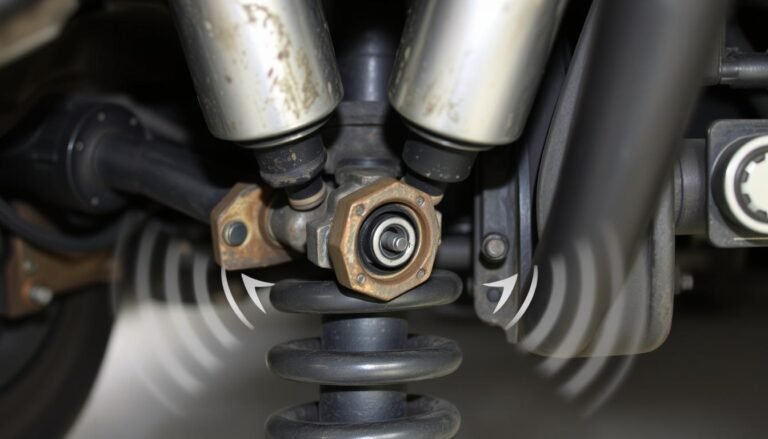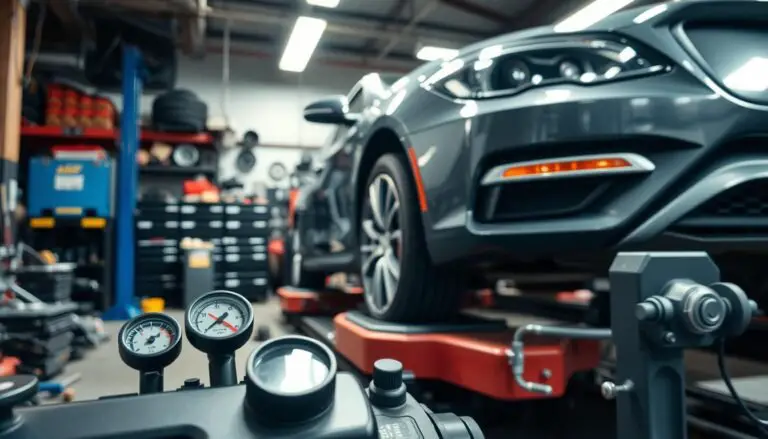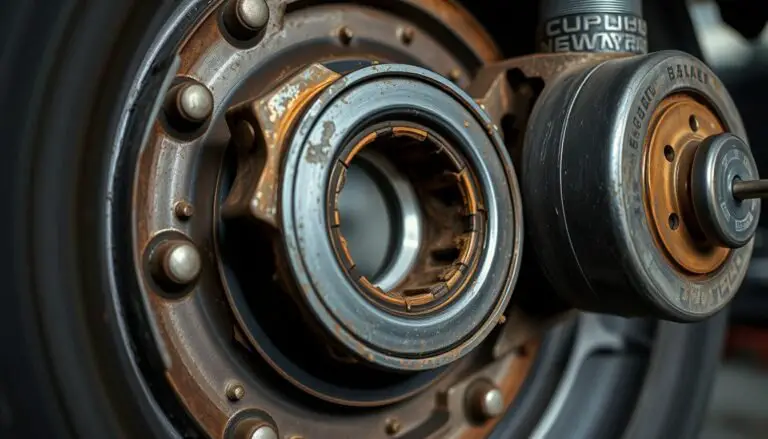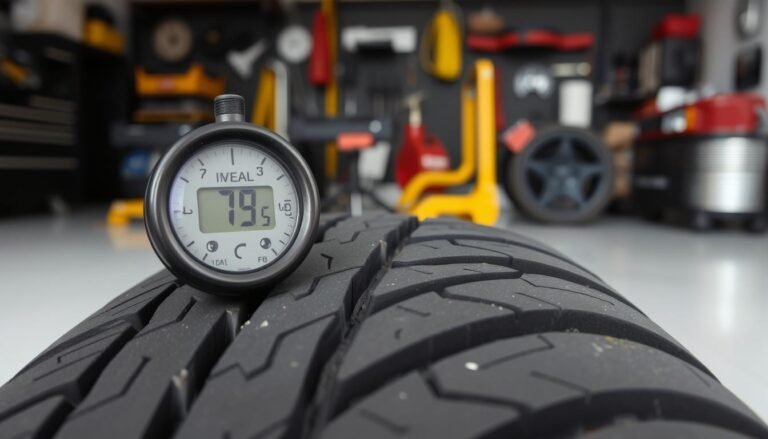What is the Best Way to Prevent Flat Tires?
Keeping your vehicle’s tires in good shape is key for safe driving. Flat tires can be a big problem and even a safety risk. We’ll look at the best ways to avoid flat tires, like regular tire care, watching out for road hazards, and using spare tires and sealants.
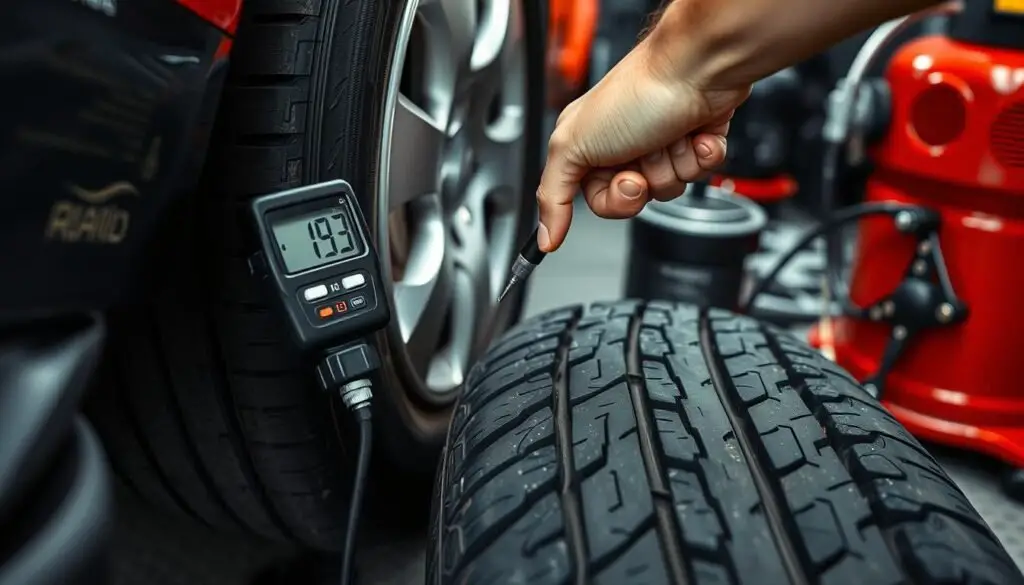
Key Takeaways:
- Regularly check and maintain proper tire inflation pressure to prevent flats
- Rotate tires as recommended to ensure even tread wear and longer tire life
- Be vigilant for road hazards that can cause tire punctures and damage
- Monitor tire tread depth and replace tires when they reach the minimum legal limit
- Keep a spare tire and the necessary tools to change it in case of a flat emergency
Tire Maintenance: The Key to Preventing Flat Tires
Keeping your tires in good shape is key to avoiding flat tires. Regular care and attention can greatly lower the chance of punctures and blowouts. This makes driving safer and more reliable.
Proper Tire Inflation
Getting the right tire pressure is crucial. Tires that are too low are more likely to get punctures and wear out faster. On the other hand, tires that are too high can affect how well your car handles and grips the road. Always check your tire pressure and adjust it as the manufacturer suggests.
Regular Tire Rotations
Rotating your tires regularly is also very important. It helps them wear evenly, which makes them last longer and reduces the chance of a flat. You should rotate your tires every 5,000 to 8,000 miles, or as your car’s maker recommends.
| Tire Maintenance Task | Recommended Frequency |
|---|---|
| Check Tire Pressure | Monthly |
| Rotate Tires | Every 5,000 – 8,000 miles |
| Inspect Tread Depth | Every Oil Change |
By being consistent with tire maintenance, you can make your tires last longer. This greatly reduces the chance of getting a flat tire while driving.
Road Hazards: Staying Vigilant to Avoid Punctures
Driving on roads can be dangerous for your tires. Potholes, nails, and sharp objects are everywhere. It’s important to stay alert and avoid these dangers to keep your tires safe.
Potholes can seriously damage your tires, causing punctures and blowouts. Nails and screws on the road can also puncture your tires. This can lead to slow leaks or sudden flats.
To avoid these hazards, always watch the road closely. Look out for any obstacles and slow down if needed. Keeping a safe distance from the car in front helps you react faster to dangers.
Also, make sure your tire tread is in good shape. Regular checks and timely replacements can help your tires handle road hazards better.
“Staying alert and avoiding road hazards is the best way to keep your tires in top shape and prevent costly flat tire repairs.”
By being careful and proactive, you can lower the risk of flat tires. Keep your eyes on the road and your tires in good condition. This way, you can avoid emergencies and stay safe.
Tire Tread: Monitoring Depth for Safety
Keeping your tire tread at the right depth is key for safety. The tread depth affects how well your tires grip the road, especially when it’s wet. Checking your tire tread regularly helps you know when it’s time for a new set, keeping your car safe and reliable.
Understanding Tread Wear Indicators
Today’s tires have built-in wear indicators, or “wear bars.” These are small bars across the tire’s surface. As your tires wear, these bars become more visible. When you see them, it’s time to get new tires.
When to Replace Tires
For most cars, the minimum safe tread depth is 4/32 of an inch (3.2 mm). Tires with less than this can lead to hydroplaning, poor braking, and a higher chance of a flat or blowout. If your tires are getting close to this level, it’s time to think about replacing them for your safety and that of your passengers.
| Tread Depth | Driving Conditions | Recommended Action |
|---|---|---|
| 6/32 inch (4.8 mm) or more | Good traction in most conditions | Tires are in good condition |
| 4/32 inch (3.2 mm) to 6/32 inch (4.8 mm) | Reduced traction in wet or slippery conditions | Consider replacing tires soon |
| Less than 4/32 inch (3.2 mm) | Increased risk of hydroplaning and reduced braking performance | Replace tires immediately |
By keeping an eye on your tire tread depth and replacing tires when needed, you keep your car safe and ready for any road. This is important for your safety and the safety of others on the road.
Spare Tire: Your Backup Plan for Flat Emergencies
Having a spare tire in your car is key to avoiding flat tires. It’s your safety net that keeps you moving. Let’s look at why a good spare tire is important and how it helps in emergencies.
First, make sure your spare tire is full of air and easy to get to. Check the tire pressure often to avoid delays. Knowing how to use your spare can save you time when you need it most.
- Regularly check the pressure of your spare tire to ensure it’s properly inflated
- Ensure your spare tire is easily accessible and that you know how to properly mount it
- Practice changing a tire so you’re comfortable with the process in an emergency
If you get a flat, a good spare tire can get you moving again fast. This is especially important in remote areas or bad weather. With a reliable spare tire, you’re ready for any flat tire situation.
“Having a fully functional spare tire can be a lifesaver when faced with a flat on the road.”
In summary, the spare tire is a vital part of your car’s safety kit. Keeping it in good shape and easy to reach means you can handle flat tires without stress. You’ll be able to keep going with confidence.
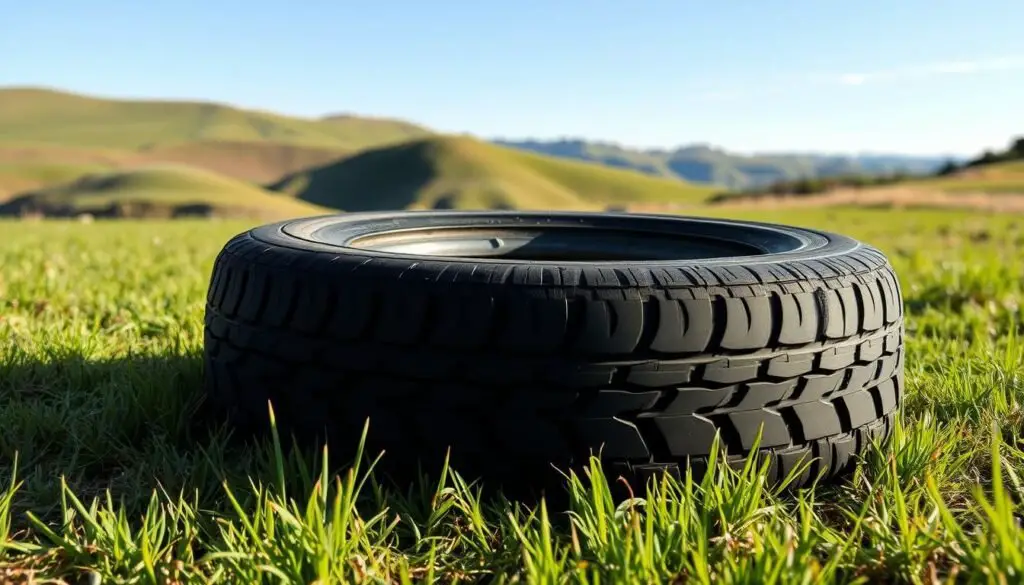
What is the best way to prevent flat tires?
Keeping your tires in good shape is key to safe driving. To avoid flat tires, use a mix of good tire care, watch out for road dangers, and be ready for surprises.
One top way to stop flat tires is to keep your tires in check. Always check the tire pressure, rotate them when needed, and replace them when the tread gets too thin. This keeps your tires safe from punctures and blowouts.
- Regularly check and maintain the proper tire pressure
- Rotate tires as per the manufacturer’s recommendations
- Replace tires when the tread depth is too low for safe driving
Also, always be alert and avoid road dangers. Watch for things like debris, potholes, and other hazards that could pop a tire. Being careful and ready can help you avoid flat tires.
“An ounce of prevention is worth a pound of cure when it comes to flat tires.”
Lastly, make sure you have a good spare tire and the right tools for emergencies. Being ready for flat tires means you can fix the problem fast and safely. This keeps you safe and saves you trouble.
By using these tips, you can greatly lower your chances of getting a flat tire. A smart approach to tire care and staying alert is the best way to dodge this common problem.
Puncture Sealants: A Temporary Fix for Flat Tires
Flat tires can really ruin your day. But, puncture sealants offer a quick fix to keep you moving. They seal small punctures, letting you drive until you can fix or replace the tire.
How Puncture Sealants Work
Puncture sealants are injected into the tire through the valve stem. When they meet air from a puncture, they seal it fast. This temporary fix lets you drive to a repair shop or home safely.
Pros and Cons of Using Sealants
Using puncture puncture sealants has both good and bad sides:
- Pros:
- They’re easy to use and convenient.
- They let you keep driving with a punctured tire.
- They can save you time and money by avoiding a tow or immediate replacement.
- Cons:
- They’re only a temporary fix, not a permanent one.
- They might not work on big or severe punctures.
- They can make fixing the tire later harder.
Puncture sealants can be handy in some cases. But, it’s key to know their limits and use them wisely. The best plan is to keep your tires in good shape and fix issues quickly to avoid needing a temporary fix.
Run-Flat Tires: A Safer Alternative to Traditional Tires
Run-flat tires are a big plus over regular tires when it comes to avoiding flat tires. They are made to keep working even after getting a puncture or losing air. This makes them a safer and more dependable choice for drivers.
These tires have a strong sidewall that can hold the car’s weight, even without air. So, you can drive on a run-flat tire that’s flat for up to 50 miles. This lets you get to a place where you can get the tire fixed or replaced safely.
| Feature | Run-Flat Tires | Traditional Tires |
|---|---|---|
| Driving Range | Up to 50 miles | 0 miles |
| Repair Ease | Can be driven to a service station | Require immediate roadside assistance |
| Safety | Reduced risk of accidents due to blowouts | Higher risk of accidents due to blowouts |
Run-flat tires also improve how well your car handles and stays stable. The strong sidewalls help with control, especially when you’re driving fast or making quick turns.
Even though run-flat tires might cost a bit more at first, they’re worth it. They help prevent getting stuck and make driving safer. Thinking about run-flat tires can give you more confidence and a safer ride.
Tire Pressure Monitoring Systems (TPMS): Early Warning for Low Pressure
Tire pressure monitoring systems (TPMS) are key in preventing flat tires. These systems keep an eye on your vehicle’s tire pressure all the time. They alert you if the pressure gets too low.
Each tire has a TPMS sensor that checks the pressure and sends the info to a control unit. If a tire’s pressure gets too low, the system warns the driver. This lets you fix the problem before it causes a blowout.

TPMS does more than just prevent flats. It also helps your tires last longer and makes your car more fuel-efficient. It keeps your tires in top shape, ensuring your safety on the road.
Even with TPMS, don’t forget to check your tire pressure regularly. It’s not a replacement for proper tire care. But with TPMS, you can feel safer and avoid unexpected tire issues.
Conclusion
Preventing flat tires is key to safe driving. A good plan includes regular tire checks, watching out for road hazards, and having a backup plan. Keeping tires properly inflated, rotating them, and checking tread depth are musts for good performance and life.
Knowing about road dangers and fixing them fast can stop punctures and blowouts. If a tire does go flat, a spare or sealant can help until you get it fixed. Also, using a Tire Pressure Monitoring System (TPMS) can warn you of low pressure early.
By using these tips, drivers can what is the best way to prevent flat tires? and drive safer. These steps can also save money on repairs, improve fuel use, and make driving more enjoyable.


